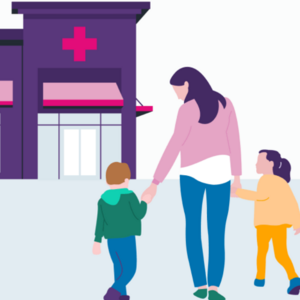
Feel better faster. Get care today.
From the clinic or your couch. Find high quality, same-day urgent care for you and your kids. Book an urgent care visit today.

If you think you're not feeling great, sometimes the last thing you want to do is to go to a doctor's office and have to wait (and worry) for who-knows-how-long to see a doctor. But you don't have to. Telemedicine is a great alternative that will get you the answers you need, so you can start feeling better as soon as possible (and practice social distancing in full health). If you’ve never had a virtual doctor’s visit before, here’s a brief rundown of what you can expect:
Your telemedicine visit should take about as long as a typical doctor’s visit, minus all the wait and travel times. To make this option even more appealing, you can do the whole thing from the comfort of your own bed, which is a definite plus when the last thing you want to do is put on real clothes and face the outside world full of mysterious germs.
Once you’ve scheduled an appointment, there are several things you’ll want to do to be prepared:
During a typical telemedicine visit, you’ll video chat with a provider and discuss your current health concerns. They’ll use all that medical knowledge they’ve acquired from years of schooling and treating patients and apply it to your situation, assessing your symptoms the same way they would if you were sitting on one of those awkward doctor’s tables. You’ll get a diagnosis, recommended treatment, and, if needed, a prescription. Just like you would in-person. Are you noticing the trend? Telemedicine care is healthcare like you’d expect it to be, you just don’t have to leave your couch to use it.
It’s not just primary care visits that can be replaced with virtual care. Many specialists have also embraced telemedicine. Appointments with dermatologists, allergists, psychiatrists, oncologists, and even obstetricians can now be booked completely online. This is a win for patients who used to have to wait weeks (or, in some cases, months) for a face-to-face appointment with a specialist.
During a virtual visit, a doctor can help with many of the same things that you’d normally have to wait days, weeks, or months, to discuss with your primary care doctor.
So, when should you book a telemedicine appointment? You might book a telemedicine visit when you have one of the following health concerns:
Right now, many routine medical visits are being postponed so that more doctors are available to care for coronavirus patients. However, you still have options when it comes to getting care. Cue telemedicine, aka virtual doctor’s visits done via video call. Telemedicine allows doctors and patients to practice safe, responsible social distancing and avoid transmission from people who aren’t showing symptoms.
(Not sure whether you need telemedicine or in-person urgent care? We have a guide for that.)
What routine healthcare can you get from a telemedicine visit?
If you’re hesitant to keep your routine appointments because of the risk of going out and spreading (or catching) the infection, you can call your doctor and ask if they have a telemedicine option. During a virtual visit, your doctor can monitor symptoms of any chronic health issues you may have, just like they would in person. They can also address any new wellness questions you’ve been meaning to ask, like questions about your weight, diet, or exercise habits. If you have questions about how telemedicine works, or what kinds of routine care you can get via telemedicine, check out our complete telemedicine guide.
Pro tip: Most of the routine doctors’ visits that you should have in your 30s can be seen using telemedicine.
Who can use telemedicine?
If you have a smartphone, tablet, or computer with internet and a webcam, you can probably use telemedicine for your routine doctors’ appointments. If you have an elective procedure coming up, like a colonoscopy or a dental exam that can’t be done via telemedicine, your doctor will probably recommend postponing it.
Will my insurance cover my telemedicine appointment?
It depends on your specific plan. Right now, to help stop the spread of the coronavirus, many insurance companies are waiving fees for telemedicine appointments to encourage you to choose virtual visits over in-person care. If you’re not sure how to figure out if your insurance company is one of them–or if your insurance covers telemedicine in the first place–you can download the Solv app, snap a photo of your insurance card, and see an outline of your specific coverages.
You need a device with a camera, microphone, and internet connection. You also need to book an appointment with a healthcare provider offering telemedicine services.
Gather your medical and insurance information, note down your symptoms, prepare any questions you have, and ensure you're in a quiet setting with good internet access.
A wide range of health concerns can be addressed, including allergies, respiratory infections, joint pains, and chronic condition management.
Yes, many specialists, including dermatologists, psychiatrists, and oncologists, offer telemedicine services.
It depends on your specific plan. Many insurance companies are currently waiving fees for telemedicine appointments due to the COVID-19 pandemic.
Anyone with a smartphone, tablet, or computer with internet and a webcam can use telemedicine for their routine doctors’ appointments.
It depends on your specific insurance plan. Many insurance companies are currently waiving fees for telemedicine appointments to encourage social distancing during the coronavirus pandemic. You can check your specific coverage by contacting your insurance provider.
Telemedicine is an excellent option when you need to consult with a healthcare provider but want to avoid the wait times, travel, and potential exposure to germs associated with in-person visits. It's particularly useful for non-emergency situations and routine check-ups.

From the clinic or your couch. Find high quality, same-day urgent care for you and your kids. Book an urgent care visit today.